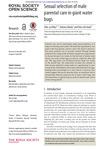Search
Now showing items 11-20 of 57
Attack risk for butterflies changes with eyespot number and size
(2016)
Butterfly eyespots are known to function in predator deflection and predator intimidation, but it is still unclear what factors cause eyespots to serve one function over the other. Both functions have been demonstrated in ...
Morphological adaptation of the calamistrum to the cribellate spinning process in Deinopoidae
(2016)
Spiders are famous for their silk with fascinating mechanical properties. However, some can further produce, process and handle nano fibres, which are used as capture threads. These ‘cribellate spiders’ bear a specialized ...
Adaptive collective foraging in groups with conflicting nutritional needs
(2016)
Collective foraging, based on positive feedback and quorum responses, is believed to improve the foraging efficiency of animals. Nutritional models suggest that social information transfer increases the ability of foragers ...
Social familiarity affects Dianamonkey alarm call responses in habitat-specific ways
(2016)
Male Diana monkeys produce loud and acoustically distinct alarm calls to leopards and eagles that propagate over long distances, much beyond the immediate group. Calling is often contagious, with neighbouring males responding ...
Comparative phylogenetic analyses uncover the ancient roots of Indo-European folktales
(2016)
Ancient population expansions and dispersals often leave enduring signatures in the cultural traditions of their descendants, as well as in their genes and languages. The international folktale record has long been regarded ...
Decreases in body temperature
(2016)
Hibernation is an adaptive strategy for surviving during periods with little or no food availability, by profoundly reducing the metabolic rate and the core body temperature (Tb). Obligate hibernators (e.g. bears, ground ...
Understanding the group dynamics and success of teams
(2016)
Complex problems often require coordinated group effort and can consume significant resources, yet our understanding of how teams form and succeed has been limited by a lack of large-scale, quantitative data. We analyse ...
Dopamine regulates termite soldier differentiation through trophallactic behaviours
(2016)
Caste polyphenism in social insects is regulated by social interactions among colony members. Trophallaxis is one of the most frequently observed interactions, but no studies have been conducted identifying the intrinsic ...
Balancing macronutrient intake in amammalian carnivore
(2016)
There is a large body of research demonstrating that macronutrient balancing is a primary driver of foraging in herbivores and omnivores, and more recently, it has been shown to occur in carnivores. However, the extent to ...
Sexual selection of male parental care in giant water bugs
(2016)
Paternal care can be maintained under sexual selection, if it helps in attracting more mates. We tested the hypothesis in two giant water bug species,Appasus majorandAppasus japonicus, that male parental care is sexually ...










